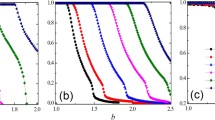Abstract
Cooperative or competitive relationship in the multi-agent systems is often depicted by a graph, which features a collective behavior. The collective behavior has been analyzed under the specific form of interaction, such as a team play in the soccer agent [1, 2, 3], and a formation in the multi-robots [4, 5]. However, a relational structure among agents is generally assumed beforehand. While, some works deal with a relationship in the group organization by an evolutionary graph network [6, 7, 8], but a functional interpretation of the graph is not discussed in explicit way. In order to represent the functional meaning of the graph and provide an evolutionary mechanism to enhance cooperation structure, we have proposed Interaction Network [9]. Hence, the model was rather abstract and a graph node was static. In this paper, we extend the model to a version of mobile nodes, which can exhibit dynamic adaptation of cooperation form in multi-agent behavior. In this paper, we model Interaction Network to deal with a team play in the collective game, and propose the decision-making mechanism to enhance efficient organized behavior. We also evaluate the tradeoff and balance between the team play and the individual play.
Access this chapter
Tax calculation will be finalised at checkout
Purchases are for personal use only
Preview
Unable to display preview. Download preview PDF.
Similar content being viewed by others
References
M. Tambe, J. Adibi, Y. Alonaizon, A. Erdem, G. Kaminka, S. Marsella, and I. Muslea. Building agent teams using an explicit teamwork model and learning. Artifical Intelligence, Vol. 110, No. 2, pp. 215–239, 1999.
Hitoshi Matsubara, Itsuki Noda, and Kazuo Hiraki. Learning of cooperative actions in multiagent systems: A case study of pass play in soccer. In Working Notes for the AAAI Symposium on Adaptation, Co-evolution and Learning in Multiagent Systems, pp. 60–67, 1996.
Peter Stone and Manuela M. Veloso. Task decomposition and dynamic role assignment for real-time strategic teamwork. In Proc. of Agent Theories, Architectures, and Languages, pp. 293–308, 1998.
J. Fredslund and M. Matarić. Robot formations using only local sensing and control. In Proc. of IEEE International Symposium on Computational Intelligence in Robotics and Automation, 2001, Vol. 2001, pp. 308–313, 2001.
T. Balch and R. Arkin. Behavior-based formation control for multi-robot teams. IEEE Transactions on Robotics and Automation, Vol. 14, pp. 926–939, December 1998.
W. Aiello, Fan Chung, and L. Lu. Random evolution in massive graphs. In IEEE Symposium on Foundations of Computer Science, pp. 510–519, 2001.
S. N. Dorogovstsev and J. F. F. Mendes. Evolution of networks. Advances in Physics, Vol. 51, pp. 1079–1187, 2002.
A.S. Mikhailov and V. Calenbuhr. From Cells to Societies, chapter 9, pp. 233–277. Springer, July 2001.
K. Sekiyama and Y. Okade. Variable interaction network based on activation and inhibition. In IEEE International Symposium on Computational Intelligence in Robotics and Automation, 2003, pp. 1551–1556, 2003.
Author information
Authors and Affiliations
Editor information
Editors and Affiliations
Rights and permissions
Copyright information
© 2007 Springer
About this paper
Cite this paper
Sekiyama, K., Okade, Y. (2007). Dynamical Reconfiguration of Cooperation Structure by Interaction Network. In: Alami, R., Chatila, R., Asama, H. (eds) Distributed Autonomous Robotic Systems 6. Springer, Tokyo. https://doi.org/10.1007/978-4-431-35873-2_33
Download citation
DOI: https://doi.org/10.1007/978-4-431-35873-2_33
Publisher Name: Springer, Tokyo
Print ISBN: 978-4-431-35869-5
Online ISBN: 978-4-431-35873-2
eBook Packages: EngineeringEngineering (R0)




